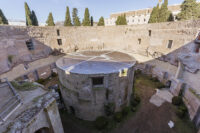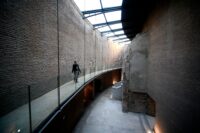 On March 1st, 2021, the Mausoleum of Augustus will open to the public again after 14 years of closure, decades more of neglect and centuries of assorted mutilations. Visitors will have to reserve their slots online (advanced bookings can be made starting Monday) and entry will be free until April 21st, Rome’s birthday. For residents of Rome, entry will free for all of 2021. Starting April 21st, visitors will enjoy new VR content added to the tour. If it’s anything like as good as the VR experience at the Domus Aurea, that will definitely be worth waiting for, particularly since so much of the ancient structure and contents are lost.
On March 1st, 2021, the Mausoleum of Augustus will open to the public again after 14 years of closure, decades more of neglect and centuries of assorted mutilations. Visitors will have to reserve their slots online (advanced bookings can be made starting Monday) and entry will be free until April 21st, Rome’s birthday. For residents of Rome, entry will free for all of 2021. Starting April 21st, visitors will enjoy new VR content added to the tour. If it’s anything like as good as the VR experience at the Domus Aurea, that will definitely be worth waiting for, particularly since so much of the ancient structure and contents are lost.
At 295 feet in diameter, Augustus’ Mausoleum was then and is still today the largest circular tomb in the world. More than 135 feet high at its peak, it towered over the Campus Martius, even eclipsing the height of the nearby Pincian Hill. It was the first dynastic tomb in Rome and the only one until Hadrian copied his predecessor and built what is now the iconic Castel Sant’Angelo.
 Augustus buried a lot of his family in the new tomb before his remains joined them in 14 A.D. Claudius was the last of the Julian-Claudian emperors buried there in 54 A.D. The last emperor whose remains were honored with inclusion in Augustus’ mausoleum was Nerva in 98 A.D. (Vespasian was in there for a second but only temporarily.) The tomb was one of Rome’s most important landmarks until it was looted in 410 A.D. when the Visigoths sacked Rome.
Augustus buried a lot of his family in the new tomb before his remains joined them in 14 A.D. Claudius was the last of the Julian-Claudian emperors buried there in 54 A.D. The last emperor whose remains were honored with inclusion in Augustus’ mausoleum was Nerva in 98 A.D. (Vespasian was in there for a second but only temporarily.) The tomb was one of Rome’s most important landmarks until it was looted in 410 A.D. when the Visigoths sacked Rome.
In the centuries after that it was stripped, fortified, burned, excavated, landscaped, converted into an arena for animal fights and a theater for Rome’s orchestra conducted by Arturo Toscanini. Mussolini tore all of that down in the misguided attempt to return the mausoleum to its original state, only of course he didn’t know what he was doing and ended up damaging it far more than the Visigoths and buffalo fights ever did. By the 70s it was so structurally unsound that it had to be closed off and the piazza was used as a bus terminus.
As ever in Rome, plans for restoration were bandied about for years before they finally became reality in 2017. At that time the projected completion date was 2019. That came and went. Then this year did the thing this year did, so really it’s something of a miracle that the Mausoleum of Augustus will open in early 2021. The last step the city has to take to complete the plan for the piazza is to move the bus terminus elsewhere. Once that’s done, Piazzale Augusto Imperatore will be pedestrian only and Augustus’ tomb and the Ara Pacis next to it will be a comfy stroll.
The mausoleum website has a misnamed “virtual experience” that will have to do for the rest of us right now. It’s the history of the tomb arranged in chapters against the backdrop of a few barely-animated models of the mausoleum at different times in its history. The content can be accessed by dragging your mouse around a lot or via menu in the upper left of the screen and dragging your mouse around a little. Within the chapters you can navigate using the Previous and Next buttons.
Chapter 1 is a truncated mini-bio of Augustus with brief blurbs about his childhood, his adoption by Julius Caesar and the appearance of a comet considered a portent of Caesar’s divinity. Chapter 2 is about the construction of the mausoleum. It’s short on detail, but it does effectively explain how Augustus started work on it when he was just 30 years old in the wake of his victory over Mark Antony at the Battle of Actium. It was a declaration of Augustus’ undying loyalty to Rome, in contrast to Antony’s final direction in his will that he be buried with Cleopatra in Alexandria.
Highlights of the rest of the “experience” are Chapter 3 about how the tomb and Ara Pacis defined this area of the Campus Martius in the Imperial era, Chapter 7 which covers the wrongs done to it in the Middle Ages (eg, Tiberius’ urn was used as a water bucket by monks), Chapter 9 about its conversion into an arena, and Chapter 11 about its transformation into an Art Nouveau theater in the early 20th century. There are a couple of great photographs of its interior that I had never seen before.